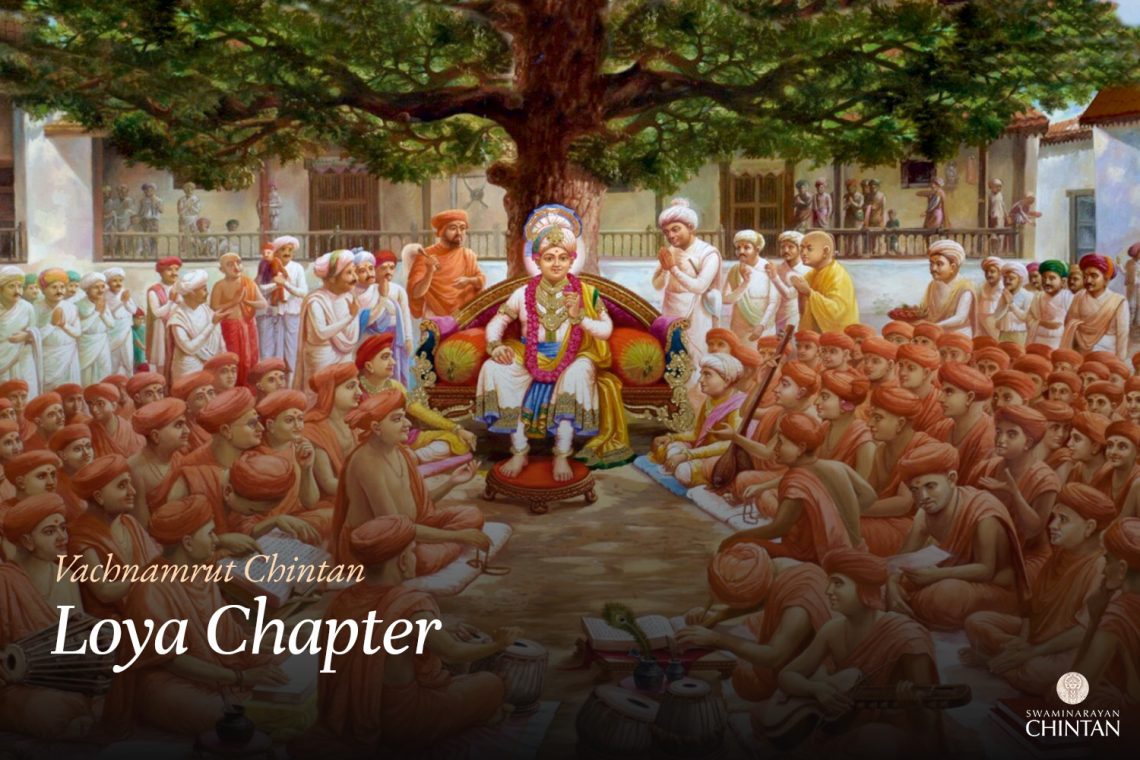Central Insights:
- Eradicating anger, Kama, and other vices from their roots.
Main Points:
- Rajoguni and Tamoguni individuals or deities are not liked by Maharaj.
- Atmanishtha, adherence to the Panch Vartman, and understanding the greatness of Maharaj can lead to the eradication of Kam (passion/lust) and other vices.
Commentary:
In this Vachanamrut, Maharaj asked the question, “What is the meaning of the word Shankar?” The munis (sages) replied that Shankar refers to one who bestows happiness. Maharaj then narrated a detailed account of how He had seen a vision of Shivji the previous night. Maharaj explained that because Shivji is a god associated with Tamogun (the attribute of ignorance), and because He is a worshiper of Narayan, the peaceful form, He does not feel affection for Shiva. However, He still respects Shivji, as He is a Tyagi (renunciate), a Yogi (ascetic), and a great devotee of Bhagwan. Maharaj further expressed His disdain for those associated with Rajogun and Tamogun — be it a person or a deity. Above all, Maharaj declared His enmity with Krodh (anger), comparing it to a rabid dog, explaining how it destroys not only the person afflicted but also others who come in contact with it. Maharaj equated Krodh with a butcher, a tiger, a leopard, or a black cobra, which senselessly takes lives without reason.
In the Gita, Kama (desire) has been described as manifesting in the form of Krodh when it is unfulfilled. In reality, Kama itself is a criminal tendency, but when it is not satisfied, it becomes aggressive and takes the form of Krodh, attacking the other person. Thus, a double offense occurs. The path of desire is to try to satisfy the mind’s cravings, but if it cannot be fulfilled, one should accept that it is a good thing and take it as a saving from sin. However, instead of doing this, Krodh aggressively retaliates against the other person, making it more dangerous than other vices. That is why Krodh has been described in the scriptures as the most destructive to one’s path of salvation. The scriptures say:
दानं व्रतानि नियमाः ज्ञानं ध्यानं हुतं जपः।
यत्नेनापि कृतं सर्वं क्रोधितस्य वृथा भवेत्॥
dānaṁ vratāni niyamāḥ jñānaṁ dhyānaṁ hutaṁ japaḥ |
yatnenāpi kṛtaṁ sarvaṁ krodhitasya vṛthā bhavet ||
Meaning: All acts of charity, vows, penance, knowledge, meditation, sacrificial offerings, and chanting of mantras — when performed with great effort — are rendered useless by anger. This is why, if a Sant becomes angry, it is particularly disgraceful, as Krodh distorts their appearance, making it ugly and monstrous.
Afterward, Shukmuni asked, “Maharaj, if a person experiences mild anger but suppresses it immediately, does it still have an impact?” Maharaj responded, “Even mild Krodh is extremely harmful. Just as everyone would flee in terror at the sight of a tiger or a snake, even if they don’t harm anyone, the mere presence of mild Krodh creates distress. Hence, even small amounts of anger should be avoided entirely.”
After this, junior Nirmananand Swami asked, “Maharaj, what is the way to uproot Kama (passion) from its root?” In response, Maharaj explained the method by saying, “First and foremost, one must possess extremely firm Atmanishtha (a deep conviction that one is the Atma and not the body). Only through such a firm realization can one control or even uproot physical needs. If there is any weakness in this, then one must strictly observe the eightfold rules of celibacy (Brahmacharya). Secondly, the observance of Panch Vartman (the five sacred vows) also helps in this process because engaging in sense pleasures fuels Kama. Hence, these indulgences must be stopped. Lastly, understanding the Mahatmya (greatness) of God is the ultimate way. When one comprehends God’s greatness, Kama is eradicated from the root. Even if Kama is removed, one must not relax in observing celibacy and the related rules, for it is only by remaining firm in them that one can maintain this state.”
Next, Bhajananand Swami asked, “Maharaj, what is the nature of the three types of Vairagya (non-attachment) — the lowest, intermediate, and highest?” A similar question is posed by Mayaram Bhatt in Vachanamrut Gadhada Pratham 11, and though the answers are somewhat different, both share the same essence.
The presence of sense objects or the opportunity for indulgence tests one’s Vairagya. The most challenging test of Vairagya comes when there is proximity or access to the opposite gender, which is especially disruptive to the mental state. In such situations, the extent to which one maintains disregard for indulgence and remains detached from it determines the level of Vairagya. It is only with Vairagya that one can maintain this detachment. The availability or proximity of indulgence does not allow the mind to remain untainted, and especially, the temptation of the opposite gender is a powerful factor in creating mental disturbances. If, despite adverse circumstances, one’s mind remains completely unaffected, then that is considered complete Vairagya.
Maharaj continued, “A person with the lowest level of Vairagya remains unaffected as long as they follow the rules prescribed in the scriptures, but if they happen to see a part of the body of the opposite gender and are attracted to it, they lose their mental discretion and purity. Such a person is said to have the lowest level of Vairagya. A person with intermediate Vairagya remains unaffected even if they see a naked person, just as they would not be disturbed by seeing a naked animal. However, when one can be in a solitary place with a member of the opposite gender, and yet remain pure in both body and mind, then that is known as the highest level of Vairagya.”
Next, Bhajananand Swami asked, “What is the nature of the three types of Gnan (knowledge regarding God) — lowest, intermediate, and highest?” Though the question here pertains to three levels of knowledge, upon reviewing Maharaj’s response and its relation to the following question, it becomes clear that the question about Gnan is actually referring to the three levels of Nishchay (conviction).
Maharaj explained, “A person with the lowest level of Gnan — or the lowest level of Nishchay — is one whose conviction in God is solely based on His Sāmarthya (power) or lack thereof. Such a person believes that if God shows His powers and miracles, He is truly God, but if these are not visible, they begin to doubt. Their conviction is built on the belief that God should instantly reward His devotees and immediately punish those who oppose Him or slander Him. Seeing this happen strengthens their belief that He is God.”
The flaw in such a decision is that when Paramatma manifests on Earth, His intent is to conceal His divine Sāmarthya. While He may occasionally show His powers, it is not His primary aim to do so, unlike how people often expect immediate results. Therefore, the real nature of God is not deeply connected to the display of Sāmarthya or miracles.
It is not that Sāmarthya or miracles are absent in God. However, when God descends on Earth, He chooses to hide these powers. As Shreeji Maharaj explains in the Vachanamrut, there are times when God, driven by some purpose or urgency, may reveal His divine Samarthya. But such displays are not constant, and God does not seek to impress through miracles all the time. In fact, true devotees of God do not desire these displays. On the contrary, God may sometimes even show weakness — behaving as if He is powerless or incapable. He may flee, cry, or express worry for the sake of some work. If such behavior contradicts the expectations of a devotee, and their hopes are not fulfilled, their Nishchay may falter. Therefore, relying on Sāmarthya alone to form one’s conviction in God is a shortcoming of the devotee. It shows an incomplete understanding of God, and thus, this is referred to as the lowest level of Nishchay or Gnan.
Then Muktanand Swami asked, “When can it be said that a person has attained complete Satsang (holy fellowship)?” Shreeji Maharaj replied, “First of all, a person must have firm Atmanishtha (conviction that one is the atma). Second, even after realizing one’s atma, one should not allow even the slightest deviation from the Panch Vartman (the five sacred vows). Third, even while living as Brahmarup (realizing oneself as Brahma), the sense of Swami-Sevakbhav (the attitude of a servant towards God) must remain firm. One must understand Bhagwan as being Nirlep (unattached) and possessing infinite Aishwarya-Vibhuti (divine powers and opulences). Strengthen devotion through the Navdha Bhakti (the nine forms of devotion), and serve the Bhakta of God with utmost devotion. When a person has achieved these, it can be said that they have attained complete Satsang. Satsang is merely a means; the real goal is to accomplish these things. If these are not attained, then Satsang is of no benefit. Such a Satsang would be in vain, with no advantage gained. The fruits of engaging in Satsang are as mentioned above.”
Next, Junior Shivanand Swami asked, “Why is it that sometimes the greatness of God is understood very well, and at other times it is not understood as clearly? What is the reason for this?” Shreeji Maharaj explained, “A Sant always follows the path of Dharma. When he reprimands someone who is walking the path of Adharma, the Dehabhimani (those attached to their body) individuals may not appreciate it, and as a result, they lose their sense of the Mahima (greatness) of the Sant. As long as the Sant doesn’t rebuke them, they continue to sing praises of his greatness. But due to Dehabhiman (attachment to the body), the sense of Mahima does not remain intact. If there is no Dehabhiman, then the sense of greatness remains at all times. It is difficult to remove an Avgun (flaw) that has arisen due to Dehabhiman. Such a person experiences intense regret, cannot find peace, and even food becomes unappealing. Like a fish out of water, he experiences restlessness until the virtues of the Sant become deeply rooted in his heart, only then does he feel relief. When a person becomes extremely humble and pleases the Sant who was displeased with him, only then is the flaw removed from the heart, and he can once again understand and appreciate the greatness of the Bhakta of God.”
Glossary
| Krodh – Anger |
| Kama – Lust |
| Rajogun – Mode of passion The quality associated with activity, desire, and attachment. |
| Tamogun – Mode of ignorance The quality associated with laziness, delusion, and lack of clarity. |
| Atmanishtha – Steadfastness in the realization of the soul The firm realization and understanding of the soul’s true nature, living beyond the influence of three kinds of body |
| Panch Vartman – The five sacred vows given by Bhagwan Swaminarayan |
| Mahatmya – Understanding the supreme glory and significance of Bhagwan, leading to increased faith and devotion. |
| Vairagya – Detachment From Everything Except God |
| Nishchay – Firm Faith in Manifested God Believing Manifested God (Bhagwan Swaminarayan) as “My Beloved God” (My Istadev) |
| Samarthya – Divine power, Bhagwan’s supernatural abilities, which are sometimes concealed. |
| Satsang – Holy fellowship |
| Swami-Sevakbhav – Master- servant attitude |
| Navdha Bhakti – Nine forms of devotion |
| Nirlep – Unattached |
| Aishwarya-Vibhuti – Divine opulences, The unlimited power and wealth of Bhagwan. |
| Dehabhiman – Attachment to the body and “I” |
| Avgun – Faults or flaws |

